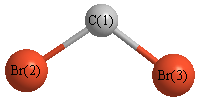Jump to
S2C1
Energy calculated at QCISD/6-311G*
| | hartrees |
|---|
| Energy at 0K | -5182.895201 |
| Energy at 298.15K | -5182.900205 |
| HF Energy | -5182.491095 |
| Nuclear repulsion energy | 324.079853 |
The energy at 298.15K was derived from the energy at 0K
and an integrated heat capacity that used the calculated vibrational frequencies.
Geometric Data calculated at QCISD/6-311G*
Point Group is C2v
Cartesians (Å)
| Atom |
x (Å) |
y (Å) |
z (Å) |
|---|
| C1 |
0.000 |
0.000 |
1.000 |
| Br2 |
0.000 |
1.563 |
-0.086 |
| Br3 |
0.000 |
-1.563 |
-0.086 |
Atom - Atom Distances (Å)
| |
C1 |
Br2 |
Br3 |
| C1 | | 1.9033 | 1.9033 |
Br2 | 1.9033 | | 3.1270 | Br3 | 1.9033 | 3.1270 | |
 More geometry information
More geometry information
Calculated Bond Angles
| atom1 |
atom2 |
atom3 |
angle |
|
atom1 |
atom2 |
atom3 |
angle |
| Br2 |
C1 |
Br3 |
110.460 |
|
Electronic energy levels
Charges, Dipole, Quadrupole and Polarizability
Jump to
S1C1
Energy calculated at QCISD/6-311G*
| | hartrees |
|---|
| Energy at 0K | -5182.877705 |
| Energy at 298.15K | -5182.882744 |
| HF Energy | -5182.509077 |
| Nuclear repulsion energy | 314.765088 |
The energy at 298.15K was derived from the energy at 0K
and an integrated heat capacity that used the calculated vibrational frequencies.
Geometric Data calculated at QCISD/6-311G*
Point Group is C2v
Cartesians (Å)
| Atom |
x (Å) |
y (Å) |
z (Å) |
|---|
| C1 |
0.000 |
0.000 |
0.726 |
| Br2 |
0.000 |
1.668 |
-0.062 |
| Br3 |
0.000 |
-1.668 |
-0.062 |
Atom - Atom Distances (Å)
| |
C1 |
Br2 |
Br3 |
| C1 | | 1.8450 | 1.8450 |
Br2 | 1.8450 | | 3.3363 | Br3 | 1.8450 | 3.3363 | |
 More geometry information
More geometry information
Electronic energy levels
Charges, Dipole, Quadrupole and Polarizability
